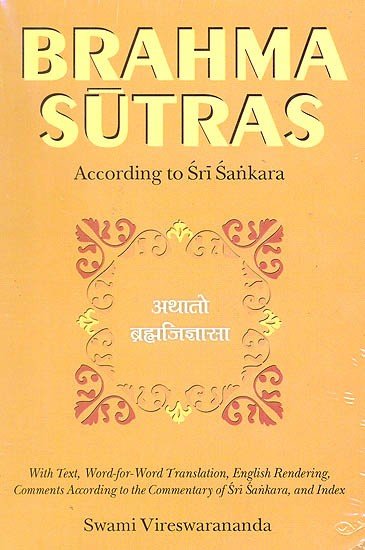Brahma Sutras (Shankara Bhashya)
by Swami Vireshwarananda | 1936 | 124,571 words | ISBN-10: 8175050063
This is the English translation of the Brahma-sutras including the commentary (Bhashya) of Shankara. The Brahma-sutra (or, Vedanta-sutra) is one of the three canonical texts of the Vedanta school of Hindu philosophy and represents an early exposition the Vedantic interpretation of the Upanishads. This edition has the original Sanskrit text, the r...
Chapter IV, Section II, Adhikarana XI
Adhikarana summary: The soul of the knower of the Saguna Brahman goes to Brahmaloka even if he should die during the southern course of the sun
Brahma-Sutra 4.2.20: Sanskrit text and English translation.
अतश्चायने’पि दक्षिणे ॥ २० ॥
ataścāyane’pi dakṣiṇe || 20 ||
ataḥ—For the same reason; cā—and; ayane—during the sun’s course; api—even; dakṣiṇe—southern.
20. And for the same reason (the soul follows the rays) even during the sun’s southern course.
An objection is raised by the opponent that the soul of the knower of Brahman who passes away during the southern course of the sun does not follow the rays to Brahmaloka, as both the Sruti and Smriti say that only one who dies during the northern course of the sun goes there. Moreover, it is also written that .Bhishma waited for the northern course of the sun to leave the body. This Sutra says that for the same reason as mentioned in the last Sutra, i.e. the unreasonableness of making the result of knowledge depend on the accident of death happening at a particular time, the knower of the Saguna Brahman goes to Brahmaloka even if he should die during the southern course of the sun. In the text, “Those who know thus ... go to light, from light to day, from day to the bright half of the month, and from that to the six months of the northern course of the sun” (Chh. 5. 10. 1), the points in the northern course of the sun do not refer to any division of time but to deities as will be shown under 4. 3. 4. Bhishma’s waiting, however, was for upholding approved custom and for showing that on account of his father’s boon he could die at will.
Brahma-Sutra 4.2.21: Sanskrit text and English translation.
योगिनः प्रति च स्मर्येते, स्मार्ते चैते ॥ २१ ॥
yoginaḥ prati ca smaryete, smārte caite || 21 ||
yoginaḥ prati—With respect to the Yogis; ca—and; smaryete—the Smriti declares; smārte—belonging to the class of Smritis; ca—and; ete—these two.
21. And (these times) the Smriti declares with respect to the Yogis; and these two (Yoga and Sankhya according to which they practise Sadhana) are classed as Smritis (and not Srutis).
In the Gita we have passages which declare that persons who die during the day etc. do not return any more to this mortal world. Vide Gita 8. 23, 24. On the strength of these texts, the opponent says that the decision of the previous Sutra cannot be correct. This Sutra refutes that objection saying that these details as to time mentioned in the Gita apply only to Yogis who practise Sadhana according to Yoga and Sankhya systems; and these two are Smritis, not Srutis. Hence the limitations as to time mentioned in them do not apply to those who meditate on the Saguna Brahman according to the Sruti texts.
